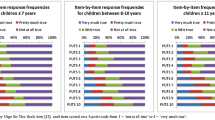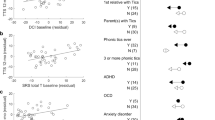Abstract
To examine the prevalence, clinical characteristics and course of children with tics identified in a community sample. This was a three-stage study. At the age of 9 to 11, parents of 8,244 children born at Aarhus University Hospital Skejby between January 1990 and April 1992 were invited to complete a screening questionnaire about tics. One year later participating parents completed the Strengths and Difficulties Questionnaire (SDQ). From December 2004 to June 2005, when the cohort was 13–15 years of age, parents of the children who screened positive for tics were interviewed in detail about tic disorders. The prevalence of Tourette Syndrome (TS) was 0.6 and 0.6% of chronic motor tics (CMT). Approximately one-third of those with a chronic tic disorder [CTD (TS and CMT)] reported remission of tics by age 13–15. On the parent-rated SDQ children with a CTD were five times more likely (OR = 5.0, 95% CI = 2.6–9.2) to fall into the clinical range of hyperactivity, twice as likely (OR = 2.2, 95% CI = 2.1–7.5) to exhibit disruptive and defiant behavior and over four times more likely to have emotional difficulties (OR = 4.7, 95% CI = 2.5–8.6) compared to children without tic disorders. Children with hyperactivity and CTD were more impaired than subjects with CTD only. Children with CTD and hyperactivity show greater symptom severity across several domains of behavior and overall impairment. In the absence of hyperactivity, children with CTD are at increased risk for emotional difficulties, but not disruptive behavior problems.



Similar content being viewed by others
References
Scahill L, Erenberg G, Berlin CM Jr, Budman C, Coffey BJ, Jankovic J et al (2006) Contemporary assessment and pharmacotherapy of Tourette syndrome. NeuroRx 3(2):192–206
Leckman JF (2002) Tourette’s syndrome. Lancet 16;360(9345):1577–86
Khalifa N, von Knorring AL (2006) Psychopathology in a Swedish population of school children with tic disorders. J Am Acad Child Adolesc Psychiatry 45(11):1346–1353
Lin H, Yeh CB, Peterson BS, Scahill L, Grantz H, Findley DB et al (2002) Assessment of symptom exacerbations in a longitudinal study of children with Tourette’s syndrome or obsessive-compulsive disorder. J Am Acad Child Adolesc Psychiatry 41(9):1070–1077
Bloch MH, Peterson BS, Scahill L, Otka J, Katsovich L, Zhang H et al (2006) Adulthood outcome of tic and obsessive-compulsive symptom severity in children with Tourette syndrome. Arch Pediatr Adolesc Med 160(1):65–69
Leckman JF, Zhang H, Vitale A, Lahnin F, Lynch K, Bondi C et al (1998) Course of tic severity in Tourette syndrome: the first two decades. Pediatrics 102(1 Pt 1):14–19
Peterson BS, Pine DS, Cohen P, Brook JS (2001) Prospective, longitudinal study of tic, obsessive-compulsive, and attention-deficit/hyperactivity disorders in an epidemiological sample. J Am Acad Child Adolesc Psychiatry 40(6):685–695
Freeman RD, Fast DK, Burd L, Kerbeshian J, Robertson MM, Sandor P (2000) An international perspective on Tourette syndrome: selected findings from 3,500 individuals in 22 countries. Dev Med Child Neurol 42(7):436–447
Centers for Disease Control and Prevention (CDC) (2009) Prevalence of diagnosed Tourette syndrome in persons aged 6–17 years- United States, 2007. Morb Mortal Wkly Rep 58(21):581–585
Spencer T, Biederman J, Coffey B, Geller D, Faraone S, Wilens T (2001) Tourette disorder and ADHD. Adv Neurol 85:57–77
Sukhodolsky DG, Scahill L, Zhang H, Peterson BS, King RA, Lombroso PJ et al (2003) Disruptive behavior in children with Tourette’s syndrome: association with ADHD comorbidity, tic severity, and functional impairment. J Am Acad Child Adolesc Psychiatry 42(1):98–105
Kadesjo B, Gillberg C (2000) Tourette’s disorder: epidemiology and comorbidity in primary school children. J Am Acad Child Adolesc Psychiatry 39(5):548–555
Pierre CB, Nolan EE, Gadow KD, Sverd J, Sprafkin J (1999) Comparison of internalizing and externalizing symptoms in children with attention-deficit hyperactivity disorder with and without comorbid tic disorder. J Dev Behav Pediatr 20(3):170–176
Rizzo R, Curatolo P, Gulisano M, Virzi M, Arpino C, Robertson MM (2007) Disentangling the effects of Tourette syndrome and attention deficit hyperactivity disorder on cognitive and behavioral phenotypes. Brain Dev 29(7):413–420
Scahill L, Sukhodolsky DG, Williams SK, Leckman JF (2005) Public health significance of tic disorders in children and adolescents. Adv Neurol 96:240–248
Kurlan R, Como PG, Miller B, Palumbo D, Deeley C, Andresen EM et al. (2002) The behavioral spectrum of tic disorders: a community-based study. Neurology 59(3):414–420
Scahill L, Williams S, Schwab-Stone M, Applegate J, Leckman JF (2006) Disruptive behavior problems in a community sample of children with tic disorders. Adv Neurol 99:184–190
Hedegaard M, Henriksen TB, Sabroe S, Secher NJ (1993) Psychological distress in pregnancy and preterm delivery. BMJ 307(6898):234–239
Goodman R (2001) Psychometric properties of the strengths and difficulties questionnaire. J Am Acad Child Adolesc Psychiatry 40(11):1337–1345
Goodman R, Ford T, Simmons H, Gatward R, Meltzer H (2003) Using the Strengths and Difficulties Questionnaire (SDQ) to screen for child psychiatric disorders in a community sample. Int Rev Psychiatry 15(1–2):166–172
Malmberg M, Rydell AM, Smedje H (2003) Validity of the Swedish version of the Strengths and Difficulties Questionnaire (SDQ-Swe). Nord J Psychiatry 57(5):357–363
Obel C, Heiervang E, Rodriguez A, Heyerdahl S, Smedje H, Sourander A et al (2004) The Strengths and Difficulties Questionnaire in the Nordic countries. Eur Child Adolesc Psychiatry 13(Suppl 2):II32–II39
Goodman R, Ford T, Richards H, Gatward R, Meltzer H (2000) The development and well-being assessment: description and initial validation of an integrated assessment of child and adolescent psychopathology. J Child Psychol Psychiatry 41(5):645–655
American Psychiatric Association (2000) Diagnostic and statistical manual of mental disorders, text revision (DSM-IV-TR), 4th edn. American Psychiatric Association, Washington
StataCorp.2003 (2003) Stata Statistical Software: release 8.0.Collage Station TX : Stata Corporation [computer program]
Hornsey H, Banerjee S, Zeitlin H, Robertson M (2001) The prevalence of Tourette syndrome in 13–14-year-olds in mainstream schools. J Child Psychol Psychiatry 42(8):1035–1039
Lanzi G, Zambrino CA, Termine C, Palestra M, Ferrari GO, Orcesi S et al (2004) Prevalence of tic disorders among primary school students in the city of Pavia, Italy. Arch Dis Child 89(1):45–47
Stefanoff P, Wolanczyk T, Gawrys A, Swirszcz K, Stefanoff E, Kaminska A et al. (2007) Prevalence of tic disorders among schoolchildren in Warsaw, Poland. Eur Child Adolesc Psychiatry
Wang HS, Kuo MF (2003) Tourette’s syndrome in Taiwan: an epidemiological study of tic disorders in an elementary school at Taipei County. Brain Dev 25(Suppl 1):S29–S31
Khalifa N, von Knorring AL (2003) Prevalence of tic disorders and Tourette syndrome in a Swedish school population. Dev Med Child Neurol 45(5):315–319
Kurlan R, Whitmore D, Irvine C, McDermott MP, Como PG (1994) Tourette’s syndrome in a special education population: a pilot study involving a single school district. Neurology 44(4):699–702
Freeman RD (2007) Tic disorders and ADHD: answers from a world-wide clinical dataset on Tourette syndrome. Eur Child Adolesc Psychiatry 16(Suppl 1):15–23
Acknowledgments
This study was supported by: the Tourette Association (TSA), the Danish Lundbeck foundation and the county of Aarhus Research Initiative. Janne Tabori Kraft, Tine Brink Henriksen and Carsten Obel have no financial relationships to disclose. Søren Dalsgaard has previously received speakers’ honoraria from Eli Lilly and Novartis Pharmaceuticals but has no current financial disclosure. Per Hove Thomsen is on the advisory board of Eli Lilly Denmark, and has received speakers’ honoraria from Novartis and Jannsen-Cilag. Lawrence Scahill has been a consultant for NeuroSearch, Boehringer-Ingelheim, Pfizer, BioMarin, Hoffman-Roche and has received research funding from Seaside Pharmaceuticals and Shire Pharmaceuticals. Support for Lawrence Scahill comes from NIMH grants (CTSAR01MH070802, R01MH069874, and US Centers for Disease Control and Prevention).
Author information
Authors and Affiliations
Corresponding author
Rights and permissions
About this article
Cite this article
Tabori Kraft, J., Dalsgaard, S., Obel, C. et al. Prevalence and clinical correlates of tic disorders in a community sample of school-age children. Eur Child Adolesc Psychiatry 21, 5–13 (2012). https://doi.org/10.1007/s00787-011-0223-z
Received:
Accepted:
Published:
Issue Date:
DOI: https://doi.org/10.1007/s00787-011-0223-z




